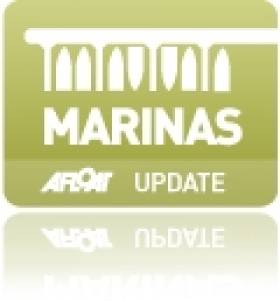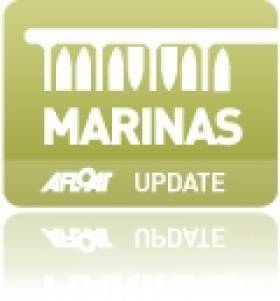Displaying items by tag: Dungarvan Harbour Sailing Club
Dungarvan Harbour Sailing Club 30–Berth Pontoon Will Attract Visiting Boats to Waterford
#tourism – A new Dungarvan pontoon facility to provide short term temporary berthing on the Copper coast in West County Waterford has been opened. The facility opened by Dungarvan Harbour Sailing Club will provide berthing for approximately 30 berths on the West Waterford coast. The new facility replaces an older interim structure which had been in place since the early 1990s.
The facility is for Club members on a daily fee basis as well as access for visiting boats. It is expected the latter aspect will support the development of marien tourism on the West Waterford coast.
The facility was opened on 11th of May the Minister for Agriculture, Food and the Marine. Simon Coveney T.D.
Speaking at the opening, the Commodore of Dungarvan Harbour Sailing Club, Joan Moloney, said "This is a proud day for sailing in Dungarvan as it represents another important development in the 68 year history of the club. The modernisation of the pontoon facilities will provide safer boat access for families and sailors and will support tourism development in the town". She then went on to thank those in the club who have worked tirelessly to bring the project to fruition.
Moloney thanked Dungarvan Town Council and in particular the unstinting efforts of Joe O'Flaherty the recently retired Town Clerk and Eoin McGarry of McGarry Construction was also praised for his effective and efficient installation of the facilities together with the suppliers Inland and Coastal. During the project a late technical hitch prevented dredging work being undertaken in addition to the pontoon installation.
Up to 100 local moored boats make good use of an existing pontoon facilty at Dungarvan quay for embarkation and disembarkation. The good news is that the town council plans to extend the pontoon which will enable boats to sail right into the centre of the town. Dungarvan is one of the most sheltered harbours on the south coast. Dungarvan Harbour sailing club has a modern clubhouse is situated right on Dungarvan Quay in the harbour and is in the centre of Dungarvan town, adjacent to the pontoon.
Dungarvan Harbour Sailing Club

Dungarvan Harbour Sailing Club
Dungarvan has always been noted for its sailors and its great sea-faring families and the tradition of the bygone days of the coastal schooners is reflected there today in the strong active sailing club which was founded at a public meeting in the Town Hall on Friday 2nd August 1946. The first officers were Bernard Mulcahy, Commodore, Reveille Farrell, Vice Commodore, Maurice Kiely, Secretary and Joe Donovan, Treasurer.
Left: The Clubhouse
The inaugural race of the club, for the newly presented Mulcahy Cup, was held over a 6½ mile course with a fleet of four boats; Mairead built by Tyrells and owned by Bernard Mulcahy, Maise formerly of Dublin owned by Maurice and Peter Kiely, Naomh Breandáin owned by Gerard Walsh, and Jane Shore owned by James Villiers Stuart. The race was won by Maurice and Peter Kiely.
Helvick based boats then showed an interest and these craft, mostly gaff rigged salmon boats crewed by fishermen from the Helvick and Ring Gaeltacht, were usually well placed. Amongst these 'Pauls Boat' and 'Slatterys Boat' were outstanding, leaving the 'yachts' a poor second on more than one occasion.
In 1948 Reveille Farrell bought Susanna, a nine-ton Bermudan cutter designed by Norman Dallimore and built in 1936. She was to become well known for her many cruises to the West Coast of Ireland, in the English Channel, and Brittany. The most famous of these was in June 1957 when accompanied by Gerard Walsh and John Ballot she sailed to Spain and back. This was a considerable achievement at the time as it was believed that the passage across the Bay of Biscay and back again was beyond the capacity of the average cruising yacht in the normal holiday period. Coincidental with the arrival of “Susanna” some of the older boats changed hands and were lost to the club and big boat racing activity declined. They were replaced by a number of one man canvas sailing canoes, owned and frequently capsized by Col. Jack Hockin, Maurice Kiely, and Tim MacCarthy – which were the beginnings of dinghy sailing in Dungarvan Harbour.
During the winter of 1958, John and Austin Flynn built a 16’ hard chine Petrel class dinghy from plans in an American magazine. Because the design was ideally suited for home construction many Petrels quickly followed and dinghy sailing really became established in Dungarvan. There was great rivalry and competition in the fleet and each new boat came with a further refinement or new 'secret weapon' not seen on previous models. Construction methods changed from larch planking and cotton sails to plywood and terylene. In all 50 boats of the class are known to have been built, the later ones of GRP construction. An unfortunate drawback of the Petrel was the fact it was unique to Dungarvan and those interested in inter club competition had to look to other designs to compete nationally.
GP14s were popular for a while during which period the club hosted the Purcell trophy. Nowadays the dinghy fleet comprises of Wayfarers, Lasers, Mirrors and Toppers sailed by a very active junior section.
The cruiser fleet has also expanded and the burgee of DHSC has been carried far afield and its members have logged many miles from Cape Horn to the Northern Latitudes.
Although once a busy commercial port, Dungarvan in common with many other ports of its size suffered when changes in shipping practices led to a decline in the number of vessels using the port and with trade totally finished many of the old warehouses along the quayside became derelict. Reconstruction has injected new life into this area of the town and created the opportunity for Dungarvan Harbour Sailing Club to acquire a site on the quay front on which to build a clubhouse which is now the focal point of club activities.
The Town Council is currently progressing the construction of a marina, which together with the abundance of new restaurants and other onshore facilities available will firmly establish Dungarvan as a compulsory stopover for cruising yachts and greatly ease the current shortage of mooring space in the harbour.
DHSC is a family orientated club. Visitors by road and sea are welcome. Pontoons at quayside. Showers and toilets available in the Clubhouse to visitors. The Clubhouse and bar are open at the weekend from 5pm throughout the year, dinghy and cruiser racing and cruising in company during the summer.
(The above information and image courtesy of Dungarvan Harbour Sailing Club)
Dungarvan Harbour Sailing Club, c/o Andrew Corby, Davitt's Quay, Dungarvan, Co Waterford. Tel: 058 45663, email: [email protected]
Have we got your club details? Click here to get involved

























































